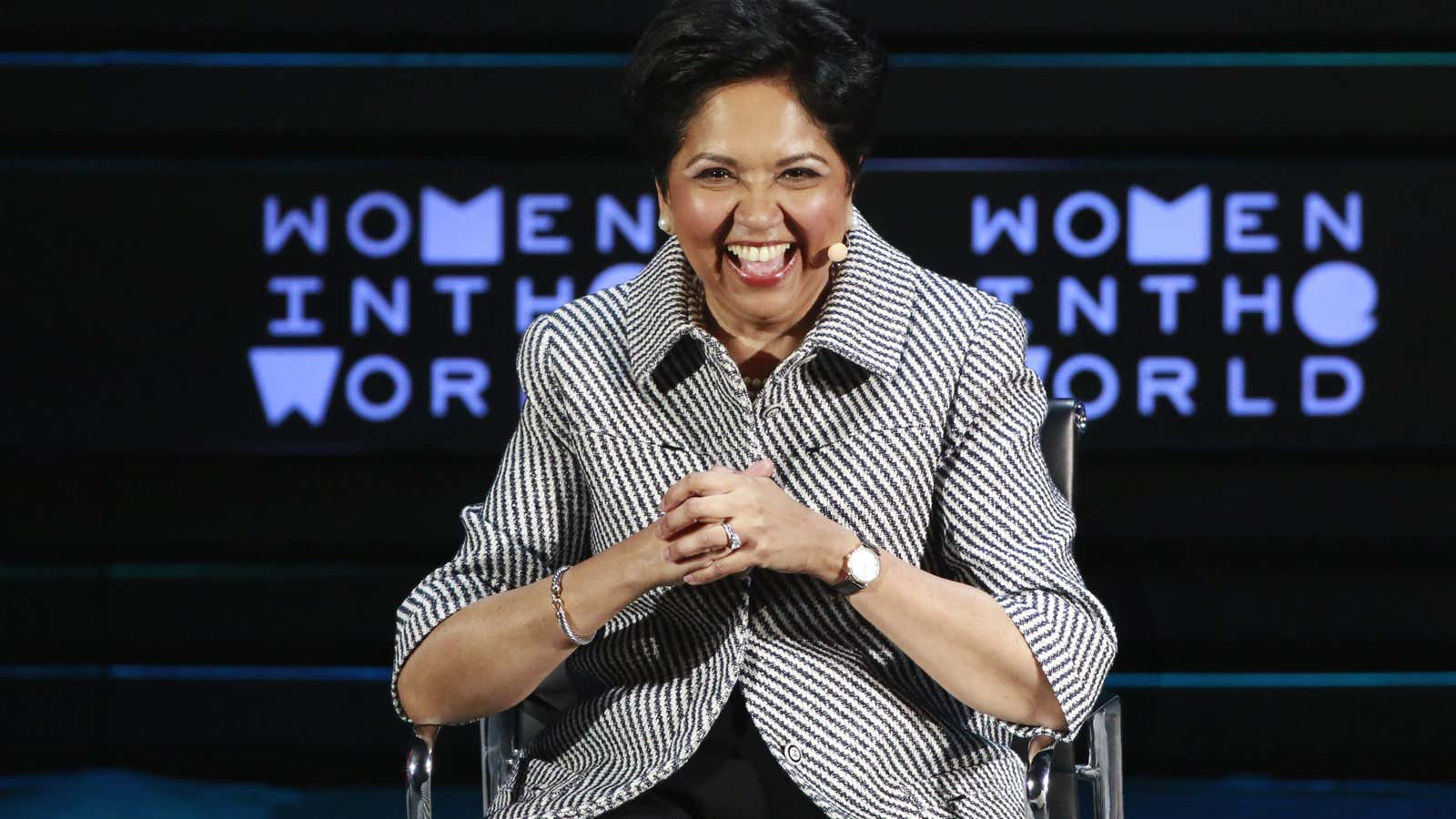Research has shown companies with more female leaders are more profitable. Yet it’s notoriously hard for women to make it to the highest post in large corporations. In fact, it seems to be getting harder. As of 2016, only 4.2% of the 500 largest US companies by revenue were led by female CEOs. That is a mere 21 women, down from 24 the previous year. And when companies hire female CEOs, and receive lots of media coverage for it, they are more likely to experience a negative market reaction.
But a few women do manage to break the highest glass ceiling in global corporations. These are the ones who are most searched on Google—most due to recent controversies surrounding their relationships with the Donald Trump administration.
Indra K. Nooyi, PepsiCo
Nooyi, 61, has been PepsiCo’s president and CEO since 2006, and was named chairman in 2007. She’s been outspoken about gender equality and diversity in the workplace for many years. At PepsiCo, Nooyi reportedly writes annual thank-you letters to over 400 parents of her senior executives, to engender familial appreciation and pride in the company. After the election of US president Trump, she criticized Trump’s comments about women during his campaign: “If we don’t nip this in the bud it is going to be a lethal force in society,” she said. However, she has since become one of three women on Trump’s 19-person business forum, the Strategic and Policy Forum.
Mary Barra, General Motors
Barra, 55, has spent over 30 years with GM. She has served as CEO since 2014, and as chairman of the company’s board of directors since 2016. The daughter of a Pontiac die-maker, Barra has been one of the key players in the recent revitalization of GM, helping push the company into the world of electric vehicle manufacturing. She was admired by former US president Barack Obama, who cited Barra in his 2014 State of the Union address as an example of American success: Our work ethic and the scope of our dreams, he said “is how the daughter of a factory worker is CEO of America’s largest automaker.” Barra, though critical of Trump, has also joined his Strategic and Policy Forum.
Virginia “Ginni” Rometty, IBM
Rometty, 59, has been with IBM since 1981, and has been credited with driving the company into cloud computing and analytics, both of which have become key businesses in recent years. She’s also been a champion of IBM’s Watson project. Rometty was announced as IBM president and CEO in 2011, and in 2012, she was made chairman of the company’s board. Rometty has recently been embroiled in controversy over an open letter she published to Trump, in which she wrote: “I know that you are committed to help America’s economy grow in ways that are good for all its people.” An IBM employee, Elizabeth Wood, responded by publishing an open letter of her own, criticizing Rometty for “offer[ing] the backing of IBM’s global workforce in support of his agenda.”
Safra A. Catz, Oracle
When Larry Ellison stepped down as CEO of Oracle in 2014, Catz, now 55, along with Mark Hurd, were named co-CEOs of the tech company. Catz, who was Ellison’s “enforcer” for many years, is currently the highest-paid female executive in the US. She, too, has faced significant criticism about her relationship with the Trump administration. Catz met one-on-one with Trump soon after his election, and joined his transition team. When Catz’s role was made public, a senior staff member, George Polisner, published an open letter on LinkedIn, in which he resigned his role and loudly criticized Catz’s decision to work with Trump.
Lynn Good, Duke Energy
Good, 58, joined Duke Energy in 2003, and was named CEO in 2013. Today, she serves as chairman, president, and CEO of Duke Energy. Good shook up the energy sector in 2016 when she began to regularly state in public that Duke would be “decarbonizing,” moving away from coal and investing in renewables and natural gas. That’s a major shift for Duke, which still gets one third of its power from coal, and has dozens of toxic coal ash ponds that still need to be cleaned up.
